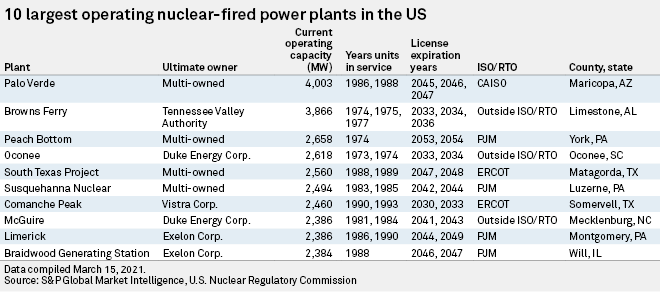Under the right conditions, hydrogen production could offer a lifeline that may prevent some aging U.S. nuclear reactors from retiring early, according to some industry experts.
While nuclear energy supplies more than half of the nation's clean electricity, many nuclear power plants are having a hard time competing with cheaper natural gas and renewable energy generation. The industry has therefore called on the federal government to develop policies that recognize the industry's value in providing clean energy to help support nuclear power.
Nuclear-produced hydrogen could provide an additional revenue stream for the nuclear fleet, potentially helping to keep aging reactors in some markets online. This is because producing hydrogen from a nuclear plant's electricity and steam can allow utilities to run the plant at full output rather than having to curtail production when lower-cost energy sources are available.
Energy industry representatives and observers see a strong potential role for nuclear energy to play in the hydrogen space. While hydrogen is a clean energy source, most of the fuel produced in the U.S. is manufactured using electricity generated by carbon-emitting natural gas-fired power plants. Nuclear power plants do not produce air pollution or carbon dioxide while operating, making them a carbon-free alternative for hydrogen production.
Such technology could become commercially viable within the next decade, perhaps even by the mid-2020s, depending on the success of various demonstration projects around the nation, experts said.
"It is up to us whether or not we do that, but it is totally doable," said Julio Friedmann, senior research scholar with the Columbia University Center on Global Energy Policy. "There is nothing in physics, chemistry or thermodynamics that stops this. There's a lot of things that get proposed that are bonkers. This is not bonkers. It's straight-up engineering in a straightforward way."
However, regulatory frameworks and market drivers will ultimately determine how quickly nuclear-produced hydrogen is scaled up, experts said. While the technology still needs to be successfully demonstrated and deployed, the nation must also create policies to incentivize investment in the space, streamline permitting for infrastructure buildout and develop markets for the produced hydrogen.
"I think we can get into the business on a pilot plant-plus scale at existing sites in a couple of years," said Eric Smith, associate director of the Tulane Energy Institute. "To say that it's commercial and competitive really depends on what the legal regulatory framework is going to be."
Some federal officials have shown interest in green hydrogen, including gas produced from nuclear energy. Given legislation introduced in recent months, opportunities for the nuclear sector are likely viable in a few years rather than decades, said Jeremy Harrell, managing director of policy at ClearPath, a nonprofit focused on advancing conservative climate and energy solutions.
"I think you're going to see a real concerted effort on the public policy front to try to accelerate hydrogen buildout as a whole," Harrell said. "I think there are some really exciting projects ... that I think will prove successful and show an opportunity. I don't think [the technology will be ready] tomorrow; I think we're talking mid-2020s ... maybe in the next couple of years even. I don't think it's decades away."

Regional viability
Experts also touted nuclear energy's efficiencies. The industry could use energy and steam from nuclear reactors to produce hydrogen through a process known as high-temperature electrolysis, which is more efficient than the more commonly used low-temperature electrolysis. However, the latter is further along in development.
Researchers are working to deploy nuclear production of hydrogen "as quickly as possible," said Shannon Bragg-Sitton, lead of integrated energy systems at the Idaho National Laboratory.
"Some of those avenues are going to focus first on low-temperature electrolysis and introducing that as an additional avenue for use of the electricity produced at a nuclear plant," Bragg-Sitton said. "So, we've been working with industry partners to evaluate the technical and the economic viability of these options and have done a number of studies in collaboration with industry."
In some markets, reactors might eventually focus more on hydrogen production rather than energy generation, Bragg-Sitton said. She expects to see large-scale commercial operation of hydrogen production within the nuclear fleet this decade.
"The viability of nuclear hydrogen production will be dependent on the region that it's implemented, and so that's why we do these very region-specific analyses," Bragg-Sitton said. "We don't know if it would be a good economic solution absolutely everywhere or just in certain markets. Just like anything, we have to evaluate where we would actually locate that."

Industry sees opportunities
The U.S. Energy Department has awarded millions of dollars through public-private partnerships to a few utilities seeking to build demonstration-scale facilities to produce hydrogen from nuclear generators.
Xcel Energy Inc. is working on a contract with the DOE to launch a demonstration project to produce hydrogen through high-temperature electrolysis. As part of its goal to produce 100% carbon-free electricity by midcentury, the utility is looking at new technologies to decarbonize the last 20% of its energy mix. Nuclear energy could play a key role in supporting renewable energy additions while offering new opportunities to hit that target, said Patrick Burke, Xcel's vice president of nuclear strategy and innovation.
"The process of making green hydrogen from nuclear power and scaling that up to be significant relative to some of that demand will take time," Burke said. "Our demonstration is two to three years. I would estimate that it would probably be three to five years or beyond before you start seeing large utility-scale production of green hydrogen."
Arizona Public Service Co. is working with the DOE to produce hydrogen at the Palo Verde nuclear plant. The utility intends to use the hydrogen to burn in a combustion turbine, decarbonizing and extending the life of its natural gas plants, said Michael Green, Arizona Public Service's general manager for nuclear policy. The utility has committed to nuclear at least through the mid-2040s and is using hydrogen production to generate the maximum value from those investments in the coming decades, he said.
"The world has, in terms of industrial economies and developed economies, set a path toward hydrogen," Green said. "We see that that has a lot of promise and certainly has a lot of opportunities and allows us to keep nuclear competitive throughout the licensed life of Palo Verde."
The next generation of nuclear reactors may also have a role to play in the hydrogen space. NuScale Power LLC, a company focused on developing new nuclear reactors, is "fielding strong interest in our hydrogen production capabilities," said Diane Hughes, NuScale's vice president of marketing and communications.
"With our commercialization plan to be ready to deliver modules late in 2027, to the extent that customers want to deploy NuScale plants for hydrogen production, it's possible to see this occurring by the end of this decade," Hughes said in an email.
In the short term, the demonstration projects may help prove the technology, said John Kotek, vice president of policy development and public affairs at the Nuclear Energy Institute.
"It starts to create a market for these technologies, for this zero-carbon hydrogen production, that I think will draw more investment into the sector," Kotek said. "We're excited about the opportunity both for existing plants but also for some of these new technologies that we're looking to bring to market."



